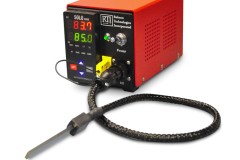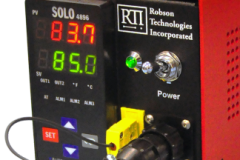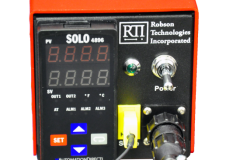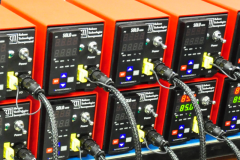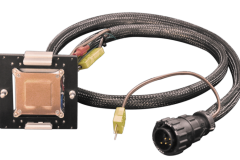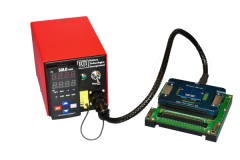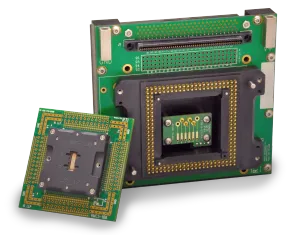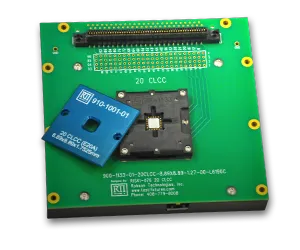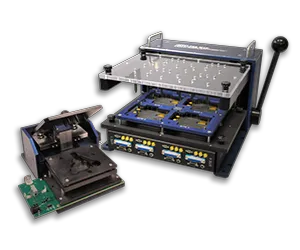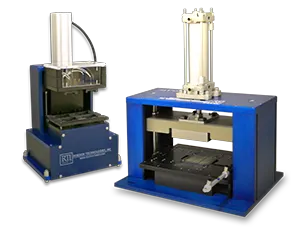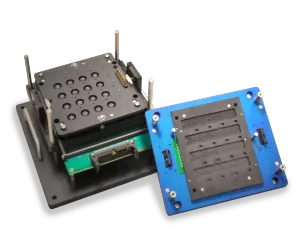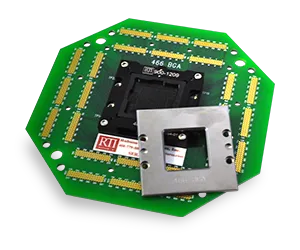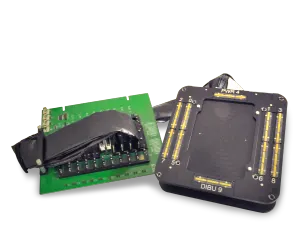PID Temperature Controller Unit
For controlled, near-die temperature regulation.
Compact yet powerful, RTI's benchtop PID temperature controllers, combined with IC Test Fixtures, provide a cost-effective solution for testing devices at ambient operational temperatures through +150°C. The unit controls a heating element embedded in a copper or NiAl block installed in the socket or lid. These blocks can act as both heatsinks and heaters to bring you to your target testing temperature quickly.
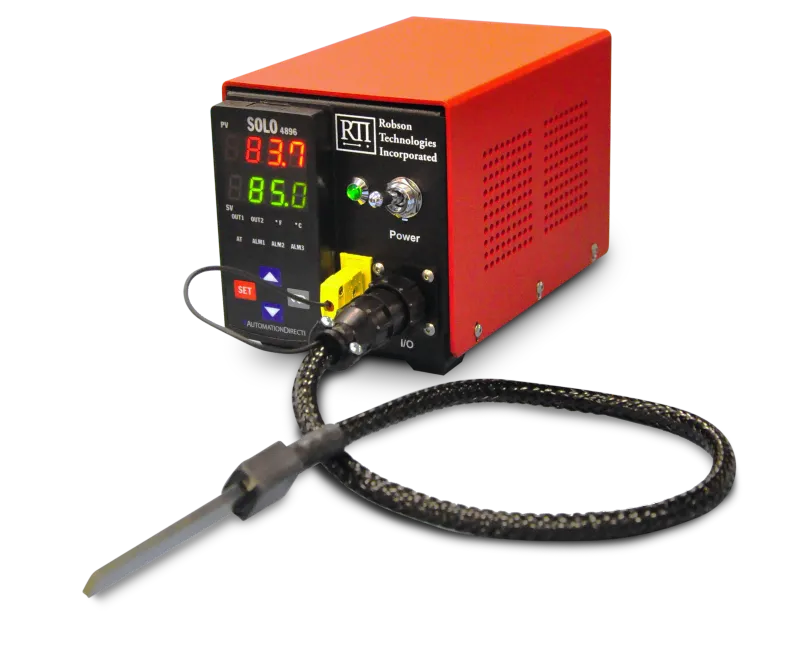
▪ Localized Temperature
At their core, cartridge heaters and RTD sensors embedded in RTI's heater blocks sit within a few millimeters of the DUT. The sensor between the DUT surface and cartridge heater provides accurate near-die level temperature values within 2°C*
▪ Safe Operation
The wrapped umbilical connecting the controller to the fixture is available in various lengths and doesn't include the heater element. There are no exposed surfaces to introduce additional heat to the test area or pose a burn hazard.
▪ Targeted Heating
Copper or Nickel plated Aluminum blocks are machined to size to apply heat at specific areas on your DUT. Whether you're heating the whole package or a targeted area within, these blocks ensure the heat is applied directly where you need it most.
▪ Programmable Units
Use the Auto-Tune feature or manually set the Proportional (P), Integral (I), and Derivative (D) values to precisely regulate the temperature between the setpoint and the measured value to drive the ramp-up time and accuracy.
PID Temperature Controller Unit
For temperature regulation at near-device level.

Compact yet powerful, RTI's Benchtop Temperature Controllers combined with IC Test Fixtures provide a cost-effective solution for testing devices at ambient operational temperatures through +150C. The unit controls a heating element embedded in a copper or NiAl block installed in the socket or lid. These blocks can act as both heatsinks and heaters to bring you to your target testing temperature quickly.
▪ Localized Temperature
At their core, cartridge heaters and RTD sensors embedded in RTI's heater blocks sit within a few millimeters of the DUT. The sensor between the DUT surface and cartridge heater provides accurate near-die level temperature values within 2°C*
▪ Safe Operation
The wrapped umbilical connecting the controller to the fixture is available in various lengths and doesn't include the heater element. There are no exposed surfaces to introduce additional heat to the test area or pose a burn hazard.
▪ Targeted Heating
Copper or Nickel plated Aluminum blocks are machined to size to apply heat at specific areas on your DUT. Whether you're heating the whole package or a targeted area within, these blocks ensure the heat is applied directly where you need it most.
▪ Programmable Units
Use the Auto-Tune feature or manually set the Proportional (P), Integral (I), and Derivative (D) values to precisely regulate the temperature between the setpoint and the measured value to drive the ramp-up time and accuracy.
Product Details & More
Here, you'll find helpful links, PDF downloads for manuals and brochures, and related blog posts. For further assistance, please contact our customer support team.
Here, you'll find helpful links, PDF downloads for manuals and brochures, and related blog posts. For further assistance, please contact our customer support team.
Introducing the PID Temperature Controller Unit
Compact Digital Temperature Controller for Semiconductor Testing
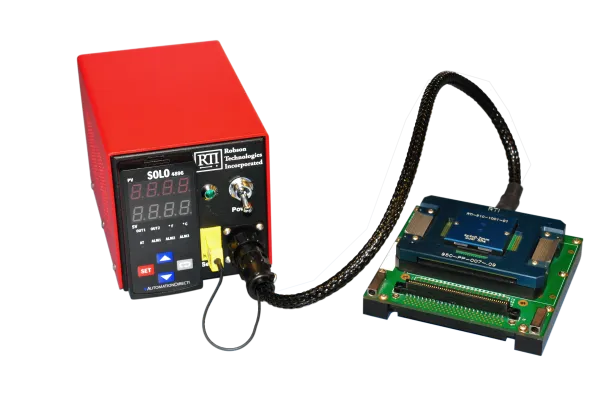
PID temperature controller plugged into a heated base of 950 Series
The PID Temperature Controller from RTI provides precise, localized temperature regulation for IC and PCB testing applications. Its benchtop design is compact—measuring just 4"x4"x6"— and integrates seamlessly into existing test setups, offering both standard and customizable configurations to suit a variety of needs.
This digital benchtop controller regulates temperature via embedded heating elements in copper or nickel-plated aluminum blocks. These blocks, installed in a fixture base or removable lid, provide consistent thermal performance at the device level. The unit supports operational heating from ambient to +100°C, with custom options available for extended ranges up to +150°C.
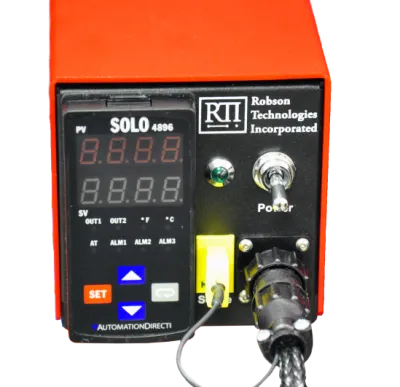
Close up to auto-tune PID control system
Key to its performance is the Auto-Tune PID control system, which offers stable and accurate temperature management. For greater flexibility, users can manually adjust the Proportional (P), Integral (I), and Derivative (D) settings to fine-tune ramp-up speeds and temperature accuracy.
Technical Specifications
- Physical Dimensions: Compact benchtop form factor at 4"x4"x6".
- Heating Range: Ambient to +100°C (custom configurations up to +150°C).
- Power Requirements: 24V, 30W heater element.
- Temperature Sensors: Options include K-type thermocouples or thin-film RTD elements, both embedded close to the DUT for precise measurement.
- Accuracy: Near-die temperature readings with a tolerance of ±2°C under stable conditions.*
- Controller: 1/8 DIN interface with Auto-Tune PID functionality and manual adjustability for precise control.
- Safety Features: Includes an in-line thermal protection fuse, a 5A heater fuse, and a 500mA controller fuse.
- Customizable Umbilicals: Available in various lengths for flexible test setups.
- Heating Blocks: Copper or nickel-plated aluminum blocks, machined to apply heat to specific areas of the DUT.
This controller is a practical tool for a range of applications, including fault-tolerance testing, device reliability validation, and optimizing thermal management strategies. Its small size and user-friendly controls make it easy to incorporate into diverse test environments, from benchtops to environmental chambers.
Ready to Take Control of Your Testing Temperatures?
Get started today—request a free, no-obligation quote for the PID Temperature Controller Unit.
Footnote:
Thermocouples and thin-film RTD sensors are installed as close to the DUT terminal "source" as possible. Variable Temperature Range assumes a highly stabilized condition. Rapid changes to the supply current and operational temperature of the DUT, sudden fluctuations in ambient temperature, and other external factors impacting the test environment may limit accuracy.

